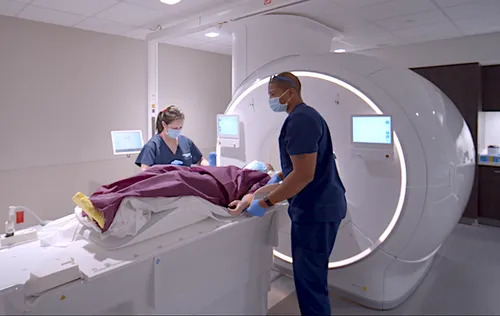UT Southwestern Medical Center
By Kevin Albuquerque, M.D. Chief of Gynecological Radiation Oncology Service Radiation Oncology and Chika Nwachukwu, M.D., Ph.D. Radiation Oncology

Adaptive radiation therapy (ART) – a new patient tumor personalized technology – is now available to treat and cure women with cervical cancer and other gynecologic tumors.
Traditional radiation therapy bases the treatment area primarily on the shape of the patient’s pelvic bones while assuming the tumor is confined within these boundaries. In contrast, ART uses advanced CT- and MRI-guided technology to conform around the actual tumor and potentially involved lymph nodes, adjusting to a much tighter treatment zone at each session.
It’s a highly personalized approach, and UT Southwestern’s adaptive radiation oncology center is the only place in North Texas with the advanced technology to treat gynecologic cancers this way.
ART allows us to adjust the treatment zone based on:
- Serial and real-time changes in the patient’s tumor size, shape, and location
- Fluctuations in positioning of organs in the pelvis, such as the bladder, intestines, and rectum.
By revising the treatment area to account for those physical changes, we radiate significantly less healthy tissue and avoid or reduce side effects from radiation therapy, such as diarrhea or urination problems.
ART is a major advancement in gynecologic cancer care. In 2022, we are embarking on two clinical trials as part of a larger effort to learn which patients benefit most from gynecological ART, and to determine the smallest yet safest margins we can make around the tumor to further reduce treatment side effects.
Who is a candidate for ART?
Women with advanced cervical, uterine, vaginal, and vulvar tumors that are changing in size or shape are prime candidates for ART. This technology also may benefit patients with gynecologic cancers, such as vaginal and endometrial, who are too sick to undergo surgery and those who cannot have anesthesia.
Gynecological tumors tend to be very sensitive to radiation due to their cellular makeup. Radiation therapy has been used successfully to shrink large gynecologic tumors completely – relieving pelvic pressure, bloating, pain and cure the cancer all together.
Gynecological tumors are often in close contact to critical tissue including the bladder, rectum, ovaries, and reproductive/sexual tissues. Because of the closeness of the tumor and these normal healthy tissues, treatment with traditional radiation can cause side effects that affect these normal tissues. Using ART, we can further reduce discomfort by redrawing the border around the actual tumor in each session to avoid treating more of the surrounding healthy tissue and decrease the side effects associated with traditional radiation.
How ART shrinks and cures gyn tumors
ART is a new kind of radiation therapy that acquires high quality images just prior to a treatment, adjusts the targets for that day to treat only involved or at-risk tissues, and very quickly re-plans the entire treatment for that day.
In contrast to traditional radiation treatment, where a plan is devised prior to starting therapy and is used for each subsequent treatment, ART provides an extra level of precision and personalization – all carried out while the patient comfortably rests on the treatment table.
ART acquires a new CT or MRI, which is captured at the beginning of each subsequent treatment session. The updated image allows us to make changes specific to that day. In the days between treatments, tumors will ideally shrink, allowing for a smaller treatment area. MRI-based radiation therapy is new technology and unique to UT Southwestern in North Texas. The machines create images so crisp and detailed we can view the millimeters of space between a tumor and a nearby organ or distinguish a tiny, tucked away tumor from its surroundings.
We use the real-time MRI information to revise the treatment plan, tightening the original boundary around the tumor to account for changes such as:
- Bladder fullness or positioning
- Intestinal fullness or positioning
- Patient posture
- Tumor shrinkage
Then, one of our medical physicists recalibrates the radiation treatment plan to the new, personalized specifications.
More treatment time, fewer side effects
ART sessions take 45-60 minutes, whereas traditional radiation takes approximately half an hour. But the extra time customizing the therapy is worthwhile. As the tumor shrinks, some women feel immediate relief from cancer-related symptoms, such as pelvic bloating, fullness, bleeding, and/or pain.
One concern some women have is that ART requires additional imaging compared with traditional radiation therapy – which includes a slightly higher, though still very low, level of imaging-related exposure, specifically with CT imaging. There is no additional ionizing radiation with MRI scanning used on some ART platforms.
Most patients say the small increase in CT imaging-related radiation is a welcome tradeoff for less unnecessary radiation of tissues around their tumor. Potentially using ART, we could avoid or reduce side effects from pelvic radiation therapy, such as:
- Urinary incontinence
- Diarrhea or bowel changes
- Rectal bleeding
ART is approved by Medicare for most cancer treatments, and the ultimate benefits of these new technologies are being determined. Your doctor will explain the risks and benefits of this treatment for your personal condition.









You must be logged in to post a comment Login